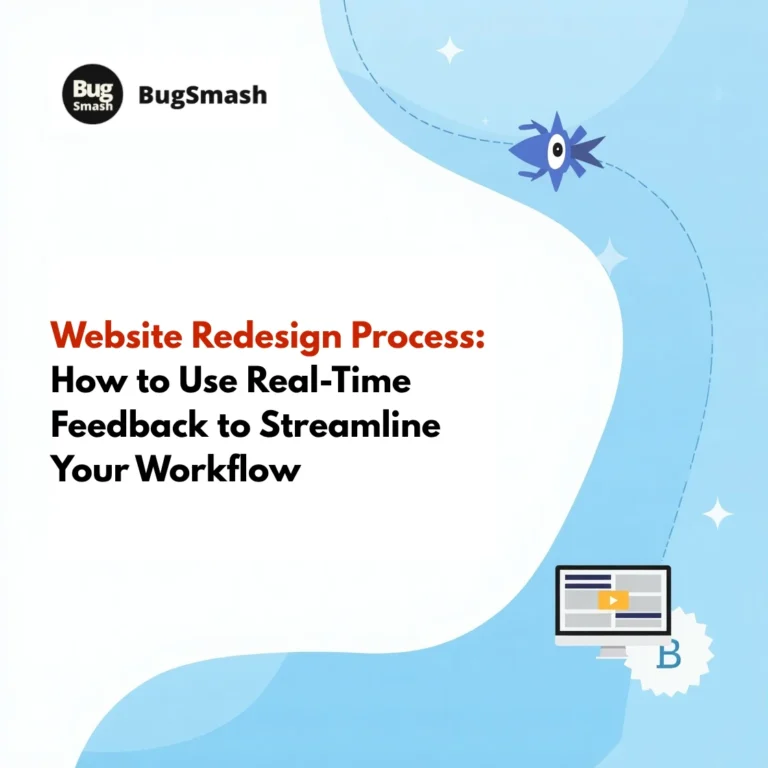Level Up Your Feedback Game
Stop drowning in feedback chaos. This list of top 8 feedback management software solutions will help you collect, analyze, and act on customer insights efficiently. Whether you're a product manager, marketer, or content creator, discover the right tool to streamline your feedback processes and boost your bottom line. We've curated the best options for 2025, including BugSmash, Zendesk, Qualtrics XM Platform, SurveyMonkey, Medallia, Typeform, GetFeedback (Salesforce), and UserVoice. Learn which feedback management software fits your needs and start gathering valuable data today.
1. BugSmash
Tired of chasing feedback across emails, screenshots, and endless chat threads? BugSmash offers a refreshing solution as a powerful, all-in-one feedback management software designed to consolidate and streamline the review and approval process for a multitude of media types. Whether you're perfecting a landing page, reviewing a video edit, annotating a PDF document, polishing an image, tweaking audio, or testing a mobile app, BugSmash centralizes all your feedback into one accessible platform. This makes it a true game-changer for busy product teams, marketing professionals, developers, QA analysts, and content creators seeking a more efficient and organized workflow.
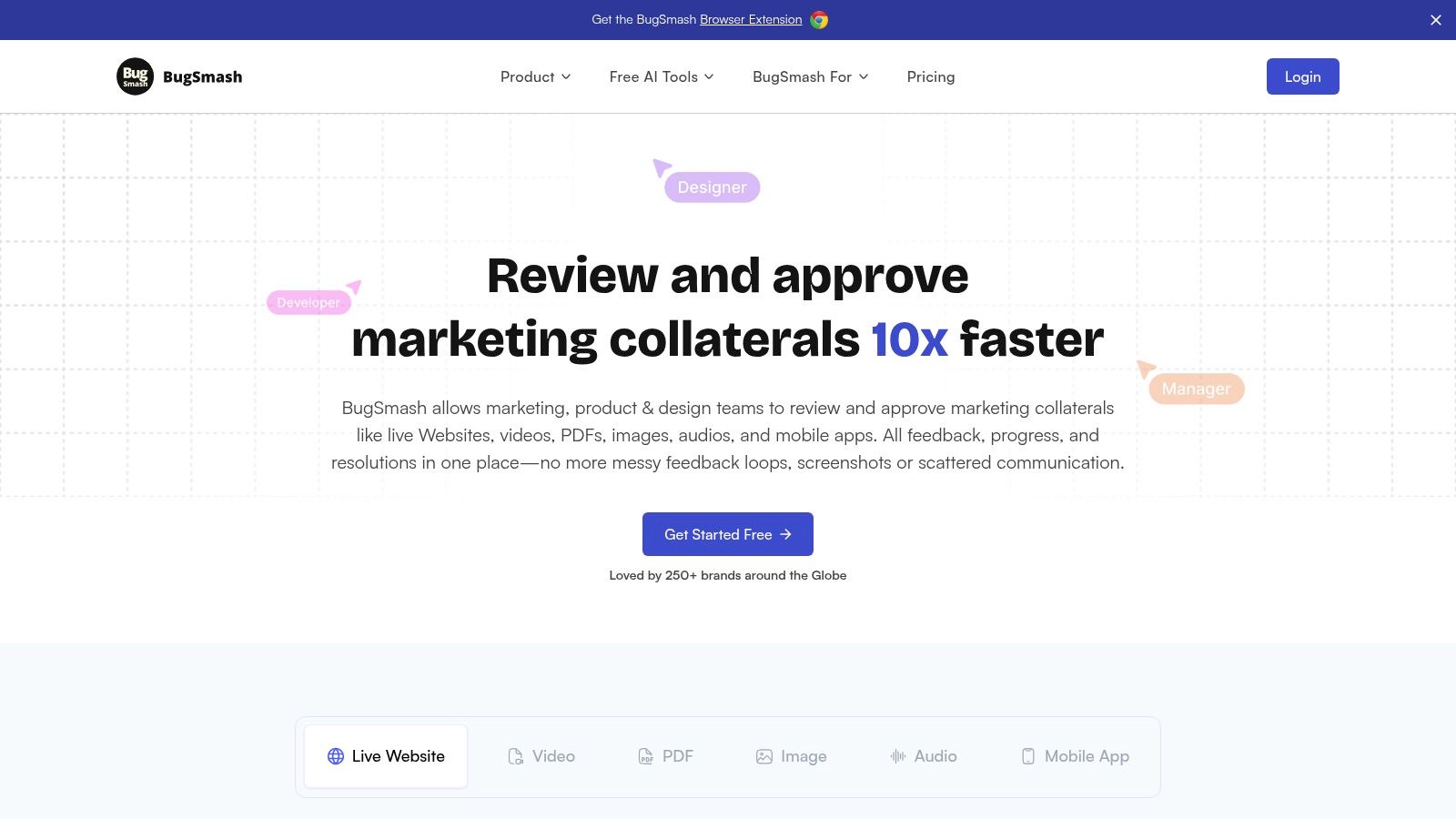
BugSmash’s core strength lies in its ability to handle diverse file formats. Unlike feedback tools limited to specific media, BugSmash supports websites, videos, PDFs, images, audio files, and even mobile apps. Imagine the convenience of reviewing a website mockup, providing feedback on a video tutorial, and annotating a design document, all within the same unified platform. This comprehensive approach eliminates the need for multiple specialized tools, simplifying feedback management and improving team collaboration. Its intuitive interface allows users to directly annotate files with highlighted sections, comments, and threaded conversations, providing clear context and fostering real-time discussion. Version tracking ensures that everyone is on the same page, while real-time updates keep the feedback loop dynamic and responsive.
The platform’s flexible sharing options further enhance collaboration. Shareable links, which require no sign-up for recipients, make it easy to gather feedback from both internal teams and external stakeholders. Whether you’re conducting internal reviews within your development team or soliciting feedback from clients on a marketing campaign, BugSmash makes the process seamless and secure. Speaking of security, BugSmash prioritizes data protection with encrypted data transmission and SOC 2 compliant storage, giving you peace of mind knowing your valuable assets are safe.
Learn more about BugSmash and how it stacks up against the competition. This detailed comparison highlights BugSmash’s unique strengths and provides valuable insights into its capabilities.
For teams already utilizing Jira and Slack, BugSmash offers seamless integrations that further embed feedback management into existing workflows. The integrations enable automatic ticket creation in Jira and notifications in Slack, accelerating feedback implementation and keeping everyone informed of progress. This streamlines communication and reduces the risk of feedback getting lost in the shuffle.
BugSmash understands the varying needs of its users, offering a robust free plan with unlimited access for smaller projects and individual creators. Paid plans provide extended storage and increased file size capabilities, catering to larger teams and more demanding projects. This tiered approach makes BugSmash accessible to a wide range of users, from individual freelancers to enterprise-level organizations.
While BugSmash offers a compelling suite of features, it’s important to note a couple of considerations. Some advanced storage and file size features require a paid subscription, so assess your needs carefully to determine the best plan for your team. Additionally, while integrations with Jira and Slack are a major plus, integration options are currently limited to these two platforms. However, BugSmash is actively working to expand its integration capabilities with other popular tools.
Getting started with BugSmash is straightforward. The browser extension empowers users to annotate live webpages and virtually any online content, eliminating the need for cumbersome screenshots and copy-pasting. This is particularly useful for website feedback and usability testing. For other file types, simply upload your files to the platform and invite collaborators to begin the review process. BugSmash’s intuitive interface makes it easy to navigate and utilize its powerful features, even for first-time users.
For product teams grappling with feedback overload, marketing teams striving for efficient campaign reviews, or developers seeking streamlined QA processes, BugSmash emerges as a valuable ally in feedback management software. Its comprehensive format support, intuitive interface, flexible sharing options, and robust security features make it a strong contender in the market. By consolidating feedback channels, streamlining communication, and automating workflows, BugSmash empowers teams to close feedback loops quicker, leading to faster turnaround times, improved product quality, and ultimately, greater success.
2. Zendesk: Centralize Your Customer Feedback for Actionable Insights
Zendesk, a leading customer service platform, goes beyond simple support tickets and offers robust feedback management capabilities that make it a powerful tool for businesses of all sizes. Its comprehensive suite of features allows you to gather, analyze, and act on customer feedback from various touchpoints, ultimately empowering you to enhance your products, services, and overall customer experience. If you’re seeking effective feedback management software, Zendesk deserves serious consideration.
Zendesk’s strength lies in its ability to consolidate feedback from multiple channels into a single, unified platform. Whether feedback arrives via email, chat, social media, or dedicated web forms, Zendesk captures it all, eliminating data silos and providing a holistic view of customer sentiment. This multi-channel approach is crucial in today's interconnected world where customers interact with brands across a multitude of platforms. Imagine having a single dashboard displaying customer comments from Twitter, feedback forms on your website, and even live chat conversations – Zendesk makes this a reality.
For product teams, Zendesk can be a game-changer. Imagine launching a new feature and wanting to gauge user reaction. Using Zendesk's customizable surveys and feedback forms, you can collect targeted feedback directly from your users. This data is invaluable for identifying bugs, understanding user behavior, and iterating on your product roadmap. No more sifting through disparate emails and spreadsheets; Zendesk organizes everything for you. Similarly, marketing teams can leverage Zendesk to analyze customer feedback on campaigns, understand brand perception, and refine their marketing strategies.
Quality analysts can utilize Zendesk to identify recurring issues and trends in customer feedback, providing valuable insights for improving product quality and resolving customer pain points. Developers can directly access customer feedback related to specific features or functionalities, enabling them to address bugs and implement improvements efficiently. For founders, product managers, and product marketing managers, Zendesk offers a powerful tool for understanding customer needs, prioritizing features, and making data-driven decisions. Even digital agencies, marketing agencies, ad agencies, course creators, and content creators can utilize Zendesk to gather feedback on their services, content, or courses, enabling them to refine their offerings and cater to their audience’s needs.
Zendesk's advanced analytics and reporting tools further elevate its feedback management capabilities. Sentiment analysis helps you understand the emotional tone behind customer feedback, allowing you to identify areas of both satisfaction and concern. This goes beyond simple metrics and provides a nuanced understanding of customer perception. The platform also provides comprehensive reporting dashboards that visualize key feedback metrics, enabling you to track trends, identify areas for improvement, and measure the effectiveness of implemented changes.
Beyond feedback collection and analysis, Zendesk streamlines workflow through automated ticket routing and prioritization. This ensures that feedback reaches the appropriate team members promptly, facilitating faster response times and improved customer satisfaction. Integration with over 1000+ third-party applications further extends Zendesk’s functionality, allowing you to connect with your existing tools and create a seamless workflow.
While Zendesk offers a powerful suite of features, it's important to consider its pricing structure. While the platform offers a user-friendly interface and easy setup, advanced features often require higher-tier plans, which can be expensive for small businesses or individual creators. Furthermore, fully leveraging Zendesk’s capabilities, especially the complex customizations, may require a learning curve.
Key Features at a Glance:
- Multi-channel feedback collection: Email, chat, social media, web forms
- Advanced analytics and sentiment analysis: Understand customer emotion and identify trends.
- Automated ticket routing and prioritization: Streamline workflows and improve response times.
- Customizable surveys and feedback forms: Gather targeted feedback for specific needs.
- Integration with 1000+ third-party applications: Connect with existing tools for a seamless workflow.
Pros:
- User-friendly interface with easy setup
- Excellent scalability for growing businesses
- Comprehensive reporting and analytics dashboard
- Strong integration ecosystem
Cons:
- Can be expensive for small businesses
- Advanced features require higher-tier plans
- Learning curve for complex customizations
Website: https://www.zendesk.com
Zendesk provides a robust solution for feedback management, empowering businesses to collect, analyze, and act on customer feedback effectively. While the pricing may be a concern for smaller businesses, the platform's powerful features, scalability, and extensive integration ecosystem make it a valuable investment for organizations looking to improve their customer experience and drive growth through actionable insights derived from customer feedback. It’s a powerful tool that can help transform raw feedback into a roadmap for improvement and innovation.
3. Qualtrics XM Platform
When it comes to robust feedback management software, Qualtrics XM Platform stands out as a leading enterprise-grade solution. If you're seeking an all-in-one platform to capture, analyze, and act on experience data (X-data) across your entire organization, Qualtrics is worth serious consideration. This powerful software goes beyond basic surveys, offering a comprehensive suite of tools for managing customer, employee, product, and brand experiences. This allows businesses to gain a 360-degree view of their audience and make data-driven decisions that enhance every touchpoint. For organizations looking to move beyond simple feedback collection and delve into sophisticated analysis and action, Qualtrics delivers the necessary depth and breadth.
Qualtrics XM distinguishes itself through its advanced capabilities. With over 100 question types, you can design highly targeted surveys to collect precise feedback. Real-time analytics and predictive intelligence empower you to identify trends and patterns as they emerge, while text analytics and sentiment analysis provide valuable insights into customer emotions and opinions. Furthermore, automated actions and workflows enable you to close the feedback loop effectively, triggering specific actions based on feedback data. For instance, a negative customer review could automatically generate a support ticket or notify a customer success manager, enabling proactive intervention. This automation is crucial for large organizations needing to manage high volumes of feedback efficiently.
Qualtrics provides a powerful engine for statistical analysis, a feature often lacking in other feedback management software. This is especially valuable for research-driven organizations, product teams needing robust A/B testing analysis, and marketing teams wanting to understand campaign effectiveness. Features like regression analysis, conjoint analysis, and T-tests provide a level of statistical rigor that allows businesses to extract meaningful insights from their data and validate hypotheses with confidence. This level of analysis can be invaluable for making strategic decisions based on solid data, not just gut feeling.
Compared to simpler feedback tools like SurveyMonkey or Typeform, Qualtrics provides a much deeper dive into data analysis and action management. While these simpler tools are great for quick polls and basic surveys, they lack the advanced features and enterprise-grade capabilities of Qualtrics. If your organization requires sophisticated statistical analysis, robust reporting, and automated workflows, Qualtrics offers a more comprehensive solution.
Implementing Qualtrics XM typically involves a consultative process with the Qualtrics team to understand your specific needs and tailor the platform accordingly. While the platform is powerful, it does have a steeper learning curve for its advanced features. Qualtrics provides extensive documentation, training resources, and customer support to help users navigate the platform and maximize its potential.
Pricing for Qualtrics is not publicly available and is generally based on specific organizational needs and the modules purchased. It's generally considered a higher-cost solution geared towards enterprise clients. This can be a drawback for smaller businesses or individual creators with limited budgets. While Qualtrics offers immense value for large organizations, its cost can be prohibitive for those with simpler feedback needs. Exploring alternative solutions might be more cost-effective for smaller businesses.
Technical Requirements for using Qualtrics are minimal, as it's a cloud-based platform accessible through a web browser. This makes it easy to deploy across the organization without complex IT infrastructure. The platform integrates with a variety of other business tools, such as CRM systems and marketing automation platforms, enabling seamless data flow and enhanced insights.
In summary, Qualtrics XM Platform shines as a powerful and comprehensive feedback management solution for enterprise-level organizations. Its advanced survey design, real-time analytics, AI-powered insights, and robust statistical analysis capabilities provide unparalleled depth for understanding and acting on customer and employee experiences. While its complexity and cost might be a barrier for smaller businesses, its extensive features and enterprise-grade security make it an ideal choice for organizations seeking a robust and scalable feedback management system. Visit https://www.qualtrics.com to explore their offerings further.
4. SurveyMonkey: Streamlining Feedback for Everyone
SurveyMonkey is a powerhouse in the world of feedback management software, consistently ranking as one of the most popular and accessible platforms available. Its intuitive design, coupled with robust features, makes it a versatile tool suitable for a broad range of users, from individual creators seeking audience feedback to large enterprises conducting complex market research. SurveyMonkey’s strength lies in its ability to simplify the often-daunting task of creating, distributing, and analyzing surveys, allowing teams to focus on what truly matters – understanding and acting on the feedback they receive. Whether you’re a product manager gathering user insights, a marketing team assessing campaign effectiveness, or a course creator evaluating student satisfaction, SurveyMonkey provides the tools you need to make data-driven decisions.
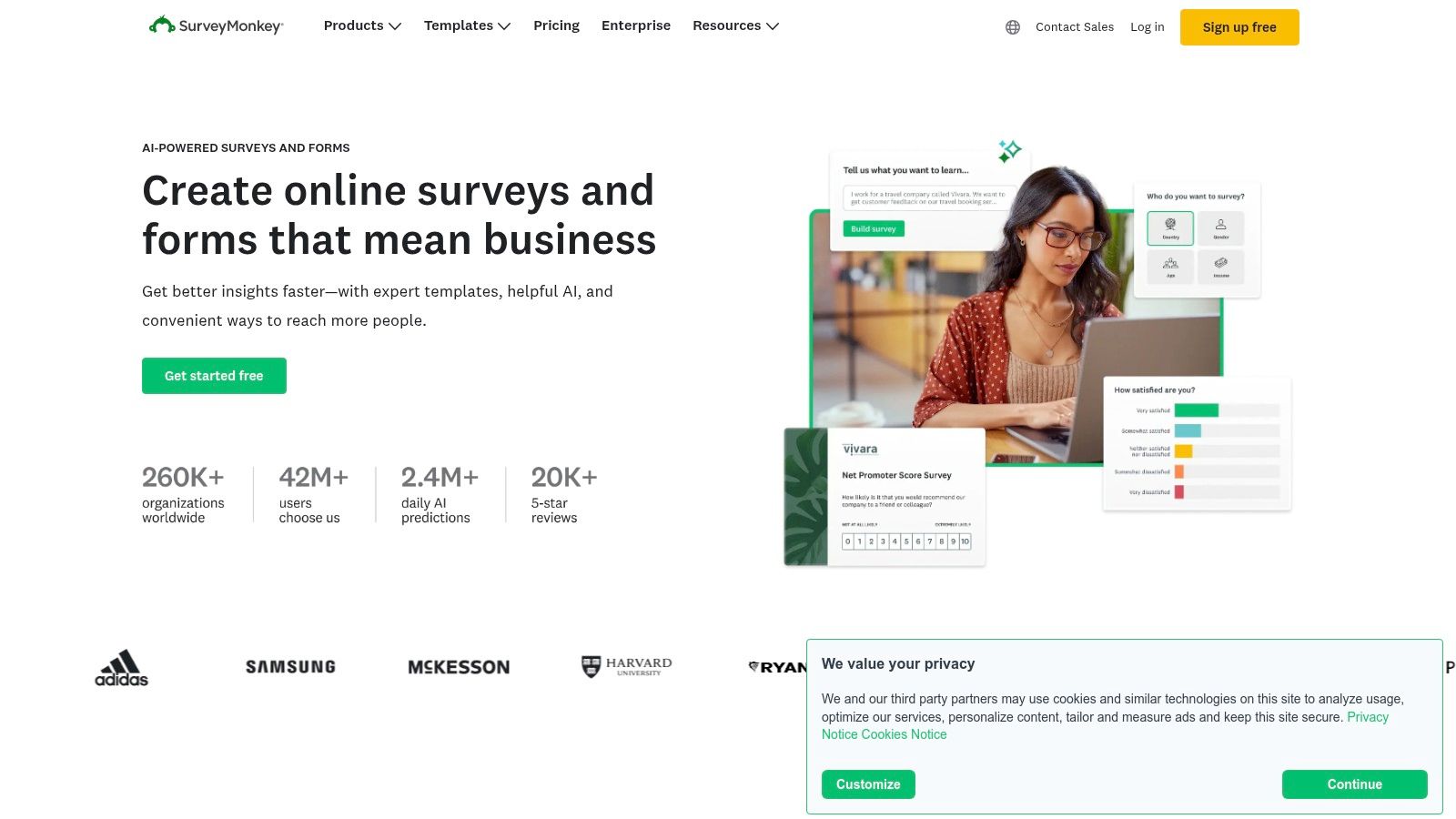
One of the key features that sets SurveyMonkey apart is its user-friendly drag-and-drop survey builder. This intuitive interface allows even those with limited technical expertise to create professional-looking surveys in minutes. The platform also boasts a vast library of pre-built templates, covering a wide array of use cases, from customer satisfaction surveys to employee engagement polls. These templates can be easily customized to match your specific needs, saving you valuable time and effort. For those seeking more advanced functionality, SurveyMonkey offers features like logic and branching, allowing you to tailor the survey experience based on respondent answers. This level of customization allows for more targeted data collection and a richer understanding of your audience.
SurveyMonkey understands the importance of mobile accessibility in today's digital landscape. All surveys created on the platform are automatically optimized for mobile devices, ensuring that your respondents can easily participate regardless of their preferred device. This responsiveness is critical for maximizing response rates and gathering comprehensive feedback. Real-time response monitoring is another valuable feature, allowing you to track survey completion rates and identify any potential issues early on. This immediate feedback loop empowers you to make adjustments and optimize your survey strategy on the fly.
Beyond data collection, SurveyMonkey also offers a range of analysis tools to help you interpret your results. While the basic plans offer more streamlined reporting, the more advanced plans unlock powerful analytics capabilities, allowing you to delve deeper into your data and uncover actionable insights. Integration with popular business tools, like Salesforce and Marketo, further enhances the platform’s utility, enabling seamless data transfer and streamlined workflows. For a broader perspective on different feedback collection methods, learn more about SurveyMonkey and other comparable tools.
While SurveyMonkey’s intuitive interface and affordability make it a compelling choice for many, it’s important to consider its limitations. Basic plans have limits on the number of responses you can collect and offer fewer customization options compared to enterprise-level solutions. The reporting capabilities in starter plans are also relatively basic, which might not suffice for users with complex analytical needs. However, considering the overall value proposition, SurveyMonkey remains a strong contender in the feedback management space, particularly for small businesses, individual creators, and teams seeking a user-friendly and cost-effective solution.
SurveyMonkey offers a tiered pricing structure to accommodate various needs and budgets. Specific pricing details are available on their website, but generally, plans range from basic free options with limited features to more comprehensive paid plans that unlock advanced functionality and higher response limits. From a technical perspective, there are no specific hardware or software requirements to use SurveyMonkey. Simply create an account, choose a plan, and start building your surveys. Its cloud-based nature makes it accessible from anywhere with an internet connection.
Compared to other feedback management software, SurveyMonkey stands out for its simplicity and ease of use. While platforms like Qualtrics offer more advanced features for enterprise-level research, they often come with a steeper learning curve and higher price tag. SurveyMonkey hits the sweet spot between functionality and affordability, making it an ideal choice for a wide range of users. It deserves its place on this list due to its accessibility, comprehensive feature set, and proven track record in helping businesses and individuals gather the feedback they need to succeed.
5. Medallia
Medallia is a robust, enterprise-grade feedback management software designed to help large organizations capture, analyze, and act on customer feedback across every touchpoint. It's a comprehensive platform that goes beyond basic surveys, leveraging AI-powered insights to drive significant improvements in customer experience. For businesses dealing with high volumes of feedback data and requiring sophisticated analysis, Medallia stands out as a powerful solution to transform customer experience into a competitive advantage. This makes it a top contender for any organization seeking a best-in-class feedback management system.
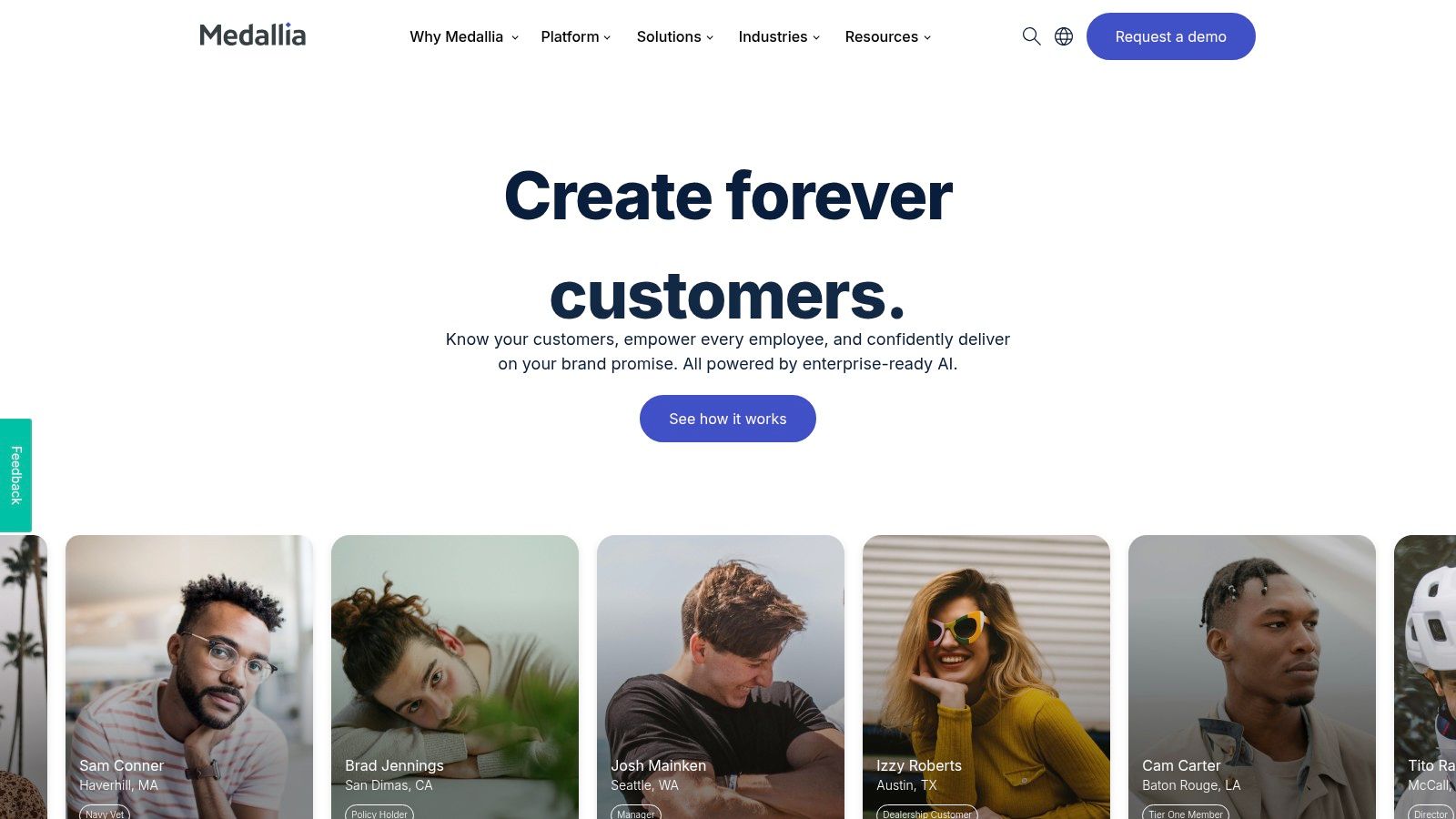
Imagine having a real-time pulse on customer sentiment across all your channels, from online surveys and social media mentions to in-store interactions and contact center calls. Medallia makes this possible with its omnichannel feedback capture capabilities. The platform seamlessly integrates with various data sources, providing a unified view of the customer journey. This holistic approach empowers organizations to identify pain points, understand customer needs, and proactively address issues before they escalate.
One of Medallia's key strengths lies in its advanced AI and machine learning capabilities. The platform uses natural language processing (NLP) and text analytics to automatically analyze unstructured feedback data, uncovering hidden trends and insights. This eliminates the need for manual analysis of large datasets, saving valuable time and resources. Furthermore, Medallia's predictive analytics features allow businesses to anticipate future customer behavior and proactively address potential issues.
Medallia’s real-time alerting and case management functionality enables organizations to respond swiftly to critical customer feedback. Automated alerts notify relevant teams of urgent issues, ensuring prompt action and improved customer satisfaction. This feature is particularly valuable for large organizations with complex customer service operations, allowing them to streamline workflows and improve response times. Role-based dashboards and reporting provide customized insights to different stakeholders, ensuring that everyone has access to the information they need to drive improvement.
For organizations looking to streamline their feedback management processes and gain a deeper understanding of their customers, Learn more about Medallia and how centralized feedback management can enhance customer experience. This insightful article provides valuable perspectives on the benefits of a centralized approach to feedback management.
While Medallia offers exceptional capabilities for feedback management software, it's essential to consider its suitability for your specific needs. The platform's robust features and enterprise-grade security come at a premium price point, making it a significant investment. It's primarily designed for large enterprises with complex customer experience requirements and the resources to manage a sophisticated platform. Implementation and setup can be complex, often requiring dedicated resources and expertise. For small to medium-sized businesses, Medallia might be overkill, and more affordable alternatives might be a better fit.
Pros:
- Excellent for handling large-scale feedback programs: Designed to handle high volumes of data from diverse sources.
- Advanced AI and machine learning capabilities: Provides deep insights through automated text and speech analytics.
- Comprehensive omnichannel approach: Captures feedback across all customer touchpoints.
- Strong enterprise security and compliance: Meets stringent security requirements for sensitive data.
Cons:
- Very expensive: Significant investment, suitable primarily for large enterprises.
- Complex implementation and setup process: Requires dedicated resources and expertise.
- Requires dedicated resources for management: Ongoing management and maintenance can be demanding.
- Overkill for small to medium businesses: Less robust and more affordable solutions might be a better fit.
Website: https://www.medallia.com
Although specific pricing and technical requirements are not publicly available, potential users can contact Medallia directly for a customized quote and detailed information on system requirements. If you are a large enterprise seeking a comprehensive feedback management solution with powerful AI capabilities and robust security, Medallia deserves serious consideration. However, smaller businesses should carefully evaluate their needs and budget before committing to this platform.
6. Typeform
Are you tired of low response rates on your feedback surveys? Do your traditional questionnaires feel impersonal and tedious? If you're looking for feedback management software that boosts engagement and provides valuable insights, Typeform is a compelling solution. Unlike conventional survey tools, Typeform specializes in crafting interactive, conversational experiences that feel more like dialogues than interrogations. This modern, mobile-first platform prioritizes user experience and sleek design, making it ideal for businesses seeking a more engaging way to collect feedback. Whether you're a product manager gathering user feedback, a marketer assessing campaign effectiveness, or a course creator evaluating student satisfaction, Typeform empowers you to connect with your audience on a deeper level.
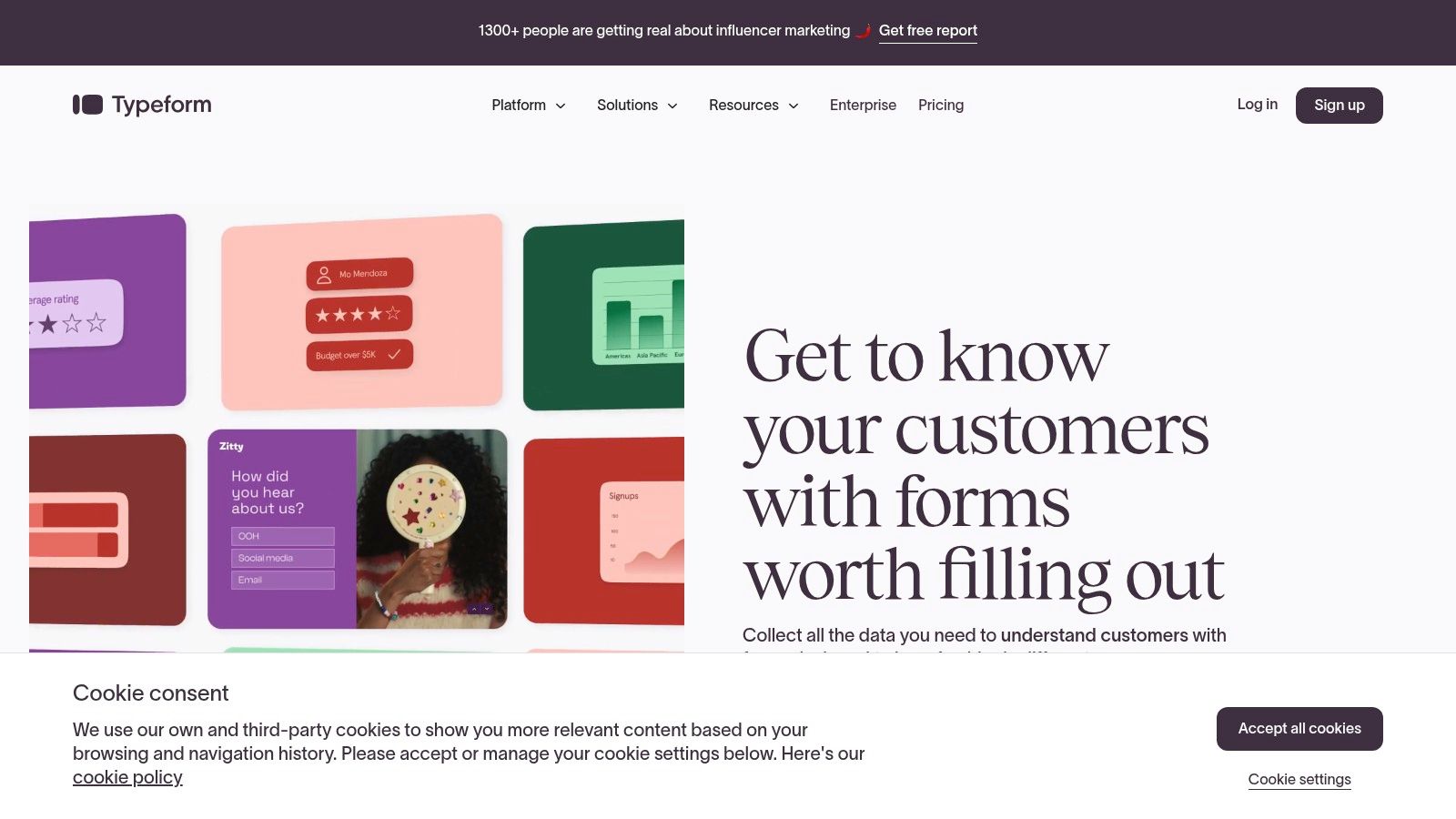
Typeform stands out from the crowd of feedback management software options with its conversational interface. This innovative approach transforms the often-dreaded survey experience into something genuinely enjoyable. Imagine replacing dull, static forms with dynamic, interactive questions that unfold naturally. This engaging format encourages respondents to provide more thoughtful and comprehensive feedback, leading to higher completion rates and richer insights. Its mobile-first design ensures your surveys look and function seamlessly on any device, catering to today's increasingly mobile audience. This is crucial for reaching a broader range of respondents and maximizing participation.
One of Typeform's biggest strengths lies in its beautiful, customizable design templates. You don't need to be a design expert to create visually appealing surveys that reflect your brand identity. Choose from a range of professionally designed templates and customize them with your logo, colors, and fonts. This level of personalization helps create a more cohesive and professional experience for your respondents, further enhancing engagement. Furthermore, features like logic jumps and conditional questions allow you to tailor the survey flow based on individual responses. This dynamic approach makes the experience more relevant and personalized for each respondent, preventing unnecessary questions and keeping them engaged throughout the process. This intelligent branching can be incredibly useful for complex surveys or when targeting specific user segments.
Typeform seamlessly integrates with over 500 applications, including popular marketing automation tools, CRM platforms, and project management software. This extensive integration capability allows you to streamline your workflows, automate data transfer, and gain a holistic view of your feedback data. For example, you can automatically send survey responses to your CRM, trigger follow-up emails based on specific feedback, or integrate data with analytics platforms for deeper analysis. This level of connectivity makes Typeform a powerful tool for feedback management within a broader business ecosystem. Beyond integrations, Typeform also offers real-time response analytics, allowing you to track key metrics as they come in. Monitor completion rates, identify trends, and gain immediate insights into respondent sentiment.
While Typeform excels in engagement and design, it's essential to be aware of its limitations. Compared to more traditional survey tools, Typeform offers fewer question types, potentially restricting the depth and complexity of your data collection. The conversational format, while highly engaging, can also be slower to complete for longer surveys, potentially impacting completion rates for some audiences. Also, while Typeform offers real-time analytics, its advanced analytical capabilities are somewhat limited compared to dedicated analytics platforms. Finally, pricing can become a factor as your response volume increases. Choosing the right plan depends on your specific needs and budget. Explore their website for detailed pricing information.
For teams seeking highly engaging feedback collection methods, Typeform offers a compelling solution. Its conversational interface, visually appealing design, and mobile-first approach make it a powerful tool for boosting response rates and gathering valuable insights. While it may not offer the same depth of analytical features as some competitors, its focus on user experience makes it an excellent choice for prioritizing engagement and creating a positive feedback experience. Whether you are a product manager, marketer, or course creator, consider Typeform (https://www.typeform.com) as a valuable addition to your feedback management software toolkit. It’s a powerful tool that can transform how you collect and leverage feedback to improve your products, services, and overall customer experience. By implementing Typeform, you can move beyond static questionnaires and create dynamic conversations that foster deeper connections with your audience and unlock actionable insights.
7. GetFeedback (Salesforce)
For businesses deeply entrenched in the Salesforce ecosystem, managing customer feedback effectively is paramount. GetFeedback, Salesforce's dedicated customer experience platform, offers a compelling solution by seamlessly integrating feedback management directly within your existing CRM workflow. This powerful tool eliminates the need for disparate systems, consolidating valuable customer insights and empowering you to act on them swiftly. This native integration makes GetFeedback a particularly strong contender for businesses already leveraging the power of Salesforce. It streamlines processes, centralizes data, and ultimately drives customer-centric improvements. If you’re looking for feedback management software that truly synchronizes with your Salesforce data, GetFeedback deserves serious consideration.

Imagine this: a customer completes a feedback survey after interacting with your support team. With GetFeedback, this response isn’t just another data point lost in a spreadsheet. It’s automatically linked to the customer's record within Salesforce, providing a 360-degree view of their experience. This allows your sales team to personalize future interactions, your marketing team to tailor campaigns, and your product team to prioritize feature development based on real user feedback. This level of integration is where GetFeedback truly shines, transforming feedback from passive data into actionable insights.
GetFeedback offers a robust suite of features designed to capture and analyze feedback across the entire customer journey. From mobile-optimized surveys and embedded feedback forms to real-time alerts and automated workflows, the platform empowers you to collect feedback at every touchpoint. CRM-connected customer journey mapping allows you to visualize the customer experience and identify key areas for improvement. Furthermore, automated follow-up actions based on responses ensure that no feedback goes unnoticed, enabling proactive engagement and issue resolution. For instance, a negative survey response could automatically trigger a case creation in Salesforce, prompting your support team to reach out and address the customer's concerns immediately.
While GetFeedback offers compelling advantages for Salesforce users, it’s important to acknowledge its limitations. The platform’s primary strength lies in its seamless integration with the Salesforce ecosystem. Consequently, businesses not already using Salesforce may find the platform’s standalone functionality limited and potentially cost-prohibitive. Implementing and fully utilizing GetFeedback also requires a certain level of Salesforce knowledge, which may necessitate training or dedicated administrative support.
Compared to standalone feedback management tools like SurveyMonkey or Typeform, GetFeedback prioritizes depth of integration over breadth of features. While these alternative platforms offer a wider range of survey customization and distribution options, they lack the inherent connection to Salesforce data that makes GetFeedback so powerful for existing users. This trade-off makes GetFeedback a specialized tool best suited for organizations seeking to leverage their Salesforce investment to improve customer experience.
While specific pricing information for GetFeedback isn't readily available and often requires contacting Salesforce directly, it's generally understood to be a premium offering, reflecting its enterprise-grade capabilities and tight Salesforce integration. Technical requirements primarily revolve around existing Salesforce subscriptions, as GetFeedback is designed to function within that environment.
Implementing GetFeedback successfully requires careful planning and consideration. Start by clearly defining your feedback goals and identifying key touchpoints in the customer journey. Work closely with your Salesforce administrator to ensure proper integration and data mapping. Leverage GetFeedback's robust reporting and analytics dashboards to track key metrics and identify areas for improvement. Finally, prioritize user training to ensure that your team can effectively utilize the platform's features and maximize its potential.
In conclusion, GetFeedback offers a powerful solution for Salesforce users looking to centralize and action customer feedback. Its native integration with the Salesforce CRM provides unparalleled access to customer data, enabling personalized interactions, targeted campaigns, and data-driven product development. While its focus on Salesforce integration may limit its appeal for non-Salesforce users, for businesses already invested in the ecosystem, GetFeedback offers a compelling path towards building a truly customer-centric organization. Visit https://www.getfeedback.com for more information and to explore how GetFeedback can revolutionize your feedback management process.
8. UserVoice: Centralize Product Feedback and Build Better Products
UserVoice is a powerful feedback management software specifically designed to empower product teams to collect, organize, and prioritize customer feedback, ultimately leading to more informed product development decisions. It's a platform built on the principle of closing the feedback loop, ensuring that customer voices are heard and directly influence the product roadmap. This makes it an invaluable tool for SaaS companies, product-driven organizations, and anyone striving to create products that truly resonate with their target audience. UserVoice stands out from general customer service feedback tools by focusing solely on product feedback, enabling a more streamlined and effective approach to product development.
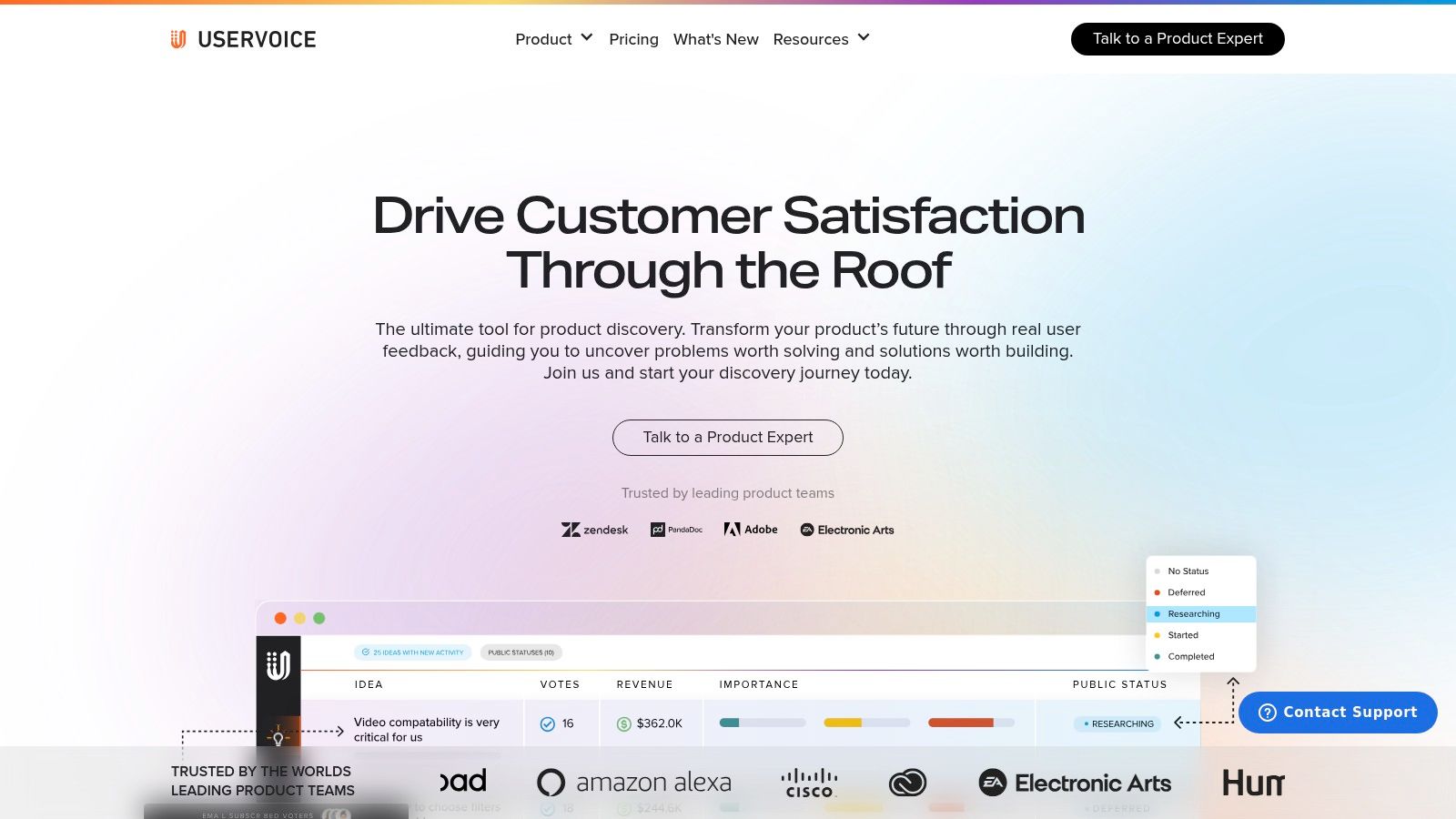
Imagine having a centralized hub where all product-related feedback, from feature requests to bug reports, is neatly organized and easily accessible. This is exactly what UserVoice offers. By providing features like public and private feedback boards, feature request voting, and product roadmap sharing, UserVoice fosters transparency and collaboration between product teams and customers. This transparency is crucial for building trust and ensuring that development efforts are aligned with customer needs.
For product managers, UserVoice simplifies the often-challenging task of prioritizing features. The platform’s voting and prioritization features allow you to gauge the popularity and importance of different requests, ensuring that development resources are focused on the features that will deliver the most value to your users. Furthermore, the ability to categorize and tag feedback provides a granular level of organization, making it easy to identify trends and patterns in user feedback. This allows product teams to proactively address issues and identify opportunities for improvement.
Developers benefit from UserVoice's integration with development tools and project management software. This seamless integration allows for a smooth transition from feedback collection to implementation, reducing friction and ensuring that feedback is directly actionable within existing workflows. Quality analysts can leverage the platform to identify recurring issues and prioritize testing efforts based on user-reported bugs. For marketing teams, UserVoice provides invaluable insights into customer preferences and pain points, informing marketing messaging and product positioning.
While UserVoice excels at product feedback management, it's important to acknowledge its limitations. It's not a comprehensive customer experience (CX) platform, meaning it may not be suitable for managing general customer service inquiries or support tickets. Other tools, like Canny and Productboard, offer a broader feature set, potentially making them a better fit for organizations needing more comprehensive CX solutions. UserVoice also tends to be more expensive than some competitors, particularly for larger organizations with extensive user bases. Pricing is typically based on the number of users or seats and while publicly available pricing is not readily accessible, it's recommended to contact UserVoice directly for a tailored quote.
Implementation Tips:
- Start with a clear objective: Define what you hope to achieve with UserVoice. Are you looking to gather feedback on a specific product feature, understand overall user sentiment, or prioritize future development efforts?
- Promote your UserVoice forum: Make it easy for users to find and provide feedback. Integrate links to your feedback forum on your website, in your product, and in your marketing communications.
- Engage with your users: Respond to feedback, acknowledge suggestions, and keep users updated on the progress of feature requests. This fosters a sense of community and encourages ongoing participation.
- Integrate with existing workflows: Connect UserVoice to your development tools and project management software to streamline the feedback-to-action process.
UserVoice truly shines when it comes to empowering product teams to build better products. Its focused approach to product feedback management, combined with its powerful features and integrations, makes it a valuable asset for any organization committed to creating user-centric products. Despite its limitations, the platform's dedication to closing the feedback loop and fostering transparency makes it a strong contender in the feedback management software landscape. For teams looking to centralize product feedback and build products that truly resonate with their target audience, UserVoice deserves serious consideration. You can explore their offerings and request a demo on their website: https://www.uservoice.com
Feedback Management Software Comparison
| Platform | Core Features/Characteristics | User Experience / Quality ★★★★☆ | Value Proposition 💰 | Target Audience 👥 | Unique Selling Points ✨ | Price Points 💰 |
|---|---|---|---|---|---|---|
| 🏆 BugSmash | Multi-format feedback: websites, videos, PDFs, audio | Intuitive, real-time annotation & comments | Free plan with extended paid tiers | Teams: marketing, product, dev, QA, agencies | Secure, SOC 2, Jira & Slack integrations, shareable links ✨ | Free & paid plans |
| Zendesk | Multi-channel feedback + analytics | User-friendly, scalable, strong integrations | Enterprise focus, can be costly | Customer support & service teams | 1000+ app integrations, automated ticketing | Mid to high price |
| Qualtrics XM Platform | Advanced surveys & real-time AI analytics | Powerful, customizable, enterprise-grade | Top-tier cost, data-driven insights | Large enterprises, research-heavy | AI insights, predictive analytics, extensive survey types | High price |
| SurveyMonkey | Easy survey builder & real-time monitoring | Very user-friendly, mobile optimized | Affordable for small-medium biz | Small to medium businesses, easy surveys | Large template library, quick setup | Low to mid price |
| Medallia | Omnichannel & AI-driven feedback capture | Comprehensive, enterprise-level | Very expensive, complex setup | Large enterprises requiring deep insights | AI analytics, predictive modeling, role-based dashboards | Very high price |
| Typeform | Conversational, engaging surveys | Highly engaging, visually appealing | Mid-range with scalable pricing | Businesses wanting high response rates & UX focus | Beautiful design, mobile-first, logic jumps | Mid price |
| GetFeedback (Salesforce) | Native Salesforce integration & real-time alerts | Seamless integration & automation | Best for SF users, pricey otherwise | Salesforce ecosystem clients | CRM-connected journey mapping, automated workflows | Mid to high price |
| UserVoice | Product feedback boards & roadmap sharing | Focused on product teams, transparent | Product-centric, pricing varies | SaaS & product-driven organizations | Feature voting, roadmap sharing, dev tool integrations | Mid to high price |
Choosing the Right Feedback Management Software
Selecting the ideal feedback management software from the myriad of options available, including powerhouses like Zendesk, Qualtrics XM Platform, SurveyMonkey, Medallia, Typeform, GetFeedback (Salesforce), and UserVoice, can feel overwhelming. This article has highlighted key features and functionalities of some of the leading feedback management software solutions, showcasing the diverse approaches to collecting and analyzing crucial feedback. The key takeaway? There's no one-size-fits-all solution. Your choice depends entirely on your specific needs, whether you're a product team at a Fortune 500 company, an individual creator building a personal brand, or a marketing agency striving for client satisfaction.
Consider your budget constraints, the size of your team, and the specific types of feedback you aim to gather. Are you focused on customer feedback, internal employee feedback, or in-depth product feedback? Seamless integration with your existing tool stack is another critical factor, as is the depth and breadth of analytics you require to extract actionable insights. By carefully weighing these factors and revisiting the tools explored in this article, you can confidently select the feedback management software that will best empower your organization's growth and improvement. Implementing the right software is just the first step. Ensure your team is adequately trained and that you establish clear processes for collecting, analyzing, and acting upon the feedback received. This commitment to continuous improvement will pave the way for enhanced customer satisfaction, superior products, and ultimately, a thriving business.
Ready to streamline your feedback process and gather actionable insights with ease? BugSmash offers a powerful and intuitive platform for website feedback and bug reporting, perfect for web developers, product managers, and quality analysts. Simplify your workflow and supercharge your development process – explore BugSmash today at BugSmash.




